ADENIUM SPECIES: NOTES & OBSERVATIONS
Many books, articles and websites already give a detailed account of the various species and subspecies so I will restrict myself to a few comments based on my own experiences:Many books, articles and websites already give a detailed account of the various species and subspecies so I will restrict myself to a few comments based on my own experiences:
Species Or Subspecies
Depending on who you wish to follow, Adenium is either a genus with one highly variable species (A. obesum) or a one with a number of distinct species.
The main argument, I think, for lumping all the variations together is that despite the large differences in flower and plant phenotype, a full range of intermediate forms are also seen. Maybe so, though from my limited exposure most of the "subspecies" seem very distinct and not only is it easy to identify the original "subspecies" but also recognize them in their hybrids (though this will change as the hybrids get more complex).
The argument that I would make is with respect to breeding behavior. Species, by definition, do not interbreed, and if they do so, they do so only with difficulty.
My experience with A. obesum and A. swazicum is that the two species will cross only with considerable reluctance; many hand pollinations are needed to produce a small seed pod with A. obesum as seed parent. The reciprocal cross has never succeeded. The pods so set have only a few seeds at best. More over, the F1 plants are also nearly sterile, setting seeds with difficulty. At least this is my experience- it may be different for others. I must note that my A. swazicum clones are all from habitat collected seeds while many A. swazicum clones in cultivation may be hybrids.
The same is true of A.arabicum- it is difficult or impossible to cross this with A.obesum.
For simplicity and practicality, therefore, I treat all the varieties as species in this website.
Notes And Observations On Species
Adenium obesum:
A highly variable species with a vast range of plant, leaf and flower forms. Generally self sterile, though some clones do set seed when alone. Leaves can be small or large, smooth or tomentose; growth compact and bushy or tall and lanky; caudex short and fat or tall and narrow and flower color ranging from pure white through the typical pink to deep, almost blackish red.
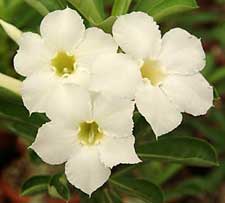 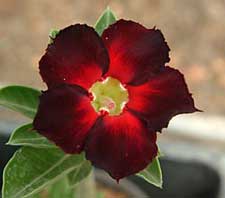 |
| A pure white selection (Khao Pra Pa Phan) from Thailand and a deep, almost blackish red first flower from one of our red crosses. The two show the color range that Adenium obesum can reach. |
Adenium multiflorum:
A lanky, tall growing species with large, glossy leaves tinged red. It flowers in winter and spring after a cool dry rest period and will not flower if kept warm and moist. Spectacular display of white flowers bordered with crimson, all the way from the terminal buds down to the small branches from the caudex.
Very poor quality in hybrids- gives very vigorous, lanky hybrids with poor flowering, characteristics, especially in pot culture. Most Adenium collections now have some A. multiflorum and A. somalense var. somalense blood in them, making the seeds from them inferior starting material for pot plant use. We have consistently weeded out such hybrids from our seed producing mother plants to ensure a more "pure" A. obesum strain that is much better suited to pot plant use.
Adenium swazicum:
Light lilac to almost magenta flowers, it is supposed to be the hardiest Adenium. I like it because of its unusual flower color and floriferous nature as well as compact growth pattern. Most clones are very floppy with drooping stems but I have some selections with erect, upright growth and dark flowers of good form.
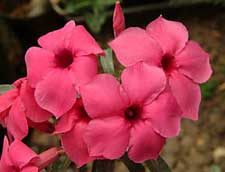 |
Purple Prince: a particularly good selection of A. swazicum we have identified for mass propagation. |
I have never been able to set seed on an Adenium swazicum. Pollination is rather difficult because the flower tube is much more compact and tighter "down there" and it is difficult to expose the stigma without breaking the style. After pollination the ovary thickens and hangs on but never develops into pods even after several months.
Hybrids with A. obesum as the pod parent are possible and are amongst the most floriferous of Adenium hybrids.
Most A. swazicum clones and many hybrids are especially susceptible to spider mite infestation.
Adenium arabicum:
Distinguished most by its outstanding caudex formation and relatively thick fleshy leaves, this is the most succulent and "desert like" species. Seeds are particularly large and give seedlings which rapidly form a nice hard caudex. The form of the plant varies and we are trying to select for superior trunk and branch formations.
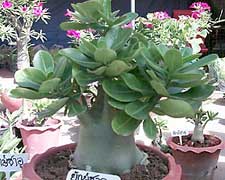 |
An exceptional Adenium arabicum I bought in Bangok- it is not quite the cultivar Golden Crown, which seems to be a selection of arabicum similar to this one but with smaller leaves and even more branches. |
There are several forms, as well documented in the literature. A form being sold in Bangkok initially as "Adenium socotranum" and now as the cultivar Golden Crown is, in its best selections, extremely caudiciform with a ring of branches topping the short, fat caudex. Leaves are relatively narrow and long (lanceolate), thinner in substance and glabrous. Flowers are typical, small and pink.
My own A. arabicum plants originate from one specimen plant I acquired from a respected collector in Ahmedabad, the late Mr.Vinubhai Goghari. He himself received the plant from a British collector before 1947 as a cutting. This plant is unusual in many respects- first it has reddish flowers (while in a leafless, dormant state in winter/spring), the stems and petioles have a distinct reddish coloration and the seed pods are fat and very often trifid- in fact this is the reason I bought this plant (for about $300) thinking its progeny would increase my seed production 50% in one go! It was not to be- I did not know about Adenium arabicum then and any way, this plant only sets seed with difficulty.
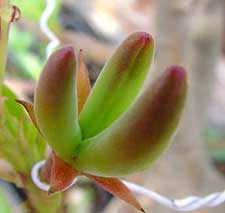 |
A young trifid seeds pod from Mr.Goghari's Adenium arabicum. Seeds are fat and relatively few in number. The flowers are red rather than pink. |
The leaves of this plant are small, softly furry and distinctly succulent. Its best progeny show exceptional form and similar leaves which are often bluish tinged, making them the most attractive of Adeniums for overall plant form. Flowers are deeper pink than the parent even in our heat. Plants can be kept dry in winter for several months- this dormant period promotes blooming.
Adenium somalense var. somalense:
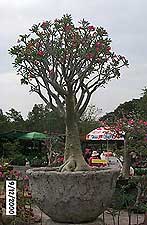 |
A huge specimen Adenium somalense var. somalense; this one is at the December show in Bangkok and for sale for about US$25,000 ! |
A robust, tall and fast growing species. Makes big plants quickly and should be a good landscape item in frost free areas. Very fecund and crosses freely. Even more than A. multiflorum this species is mixed in almost all Adenium selections world wide. One common trait that it leaves is its progeny are the strong red lines going down the throat. We discarded our plants a long time ago, in an effort (only partly successful) to maintain a relatively pure strain on A. obesum for seed production. This was necessary when we grew all our plants together but I now regret it- they do form very nice specimen plants.
Adenium somalense var. crispum:
A subspecies discovered relatively recently, it is very different from the one above. My own experience with the species is limited to some cuttings from Mark Dimmit in USA and a few seedlings from Arid Lands, all but one of which died (possibly due to a reaction to the fungicide Mancozeb). What strikes one is the compactness of the plant, its very distinctive, narrow marbled foliage and the heavily marked flowers.
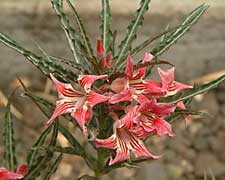 |
An Adenium somalense var. crispum clone from Mark Dimmit in USA. |
The petals are twisted and curled in all the clones I have seen (hence the specific name) and it is dominant in its hybrids. It does bring patterns never seen before to its hybrids and opens up frontiers breeders had not imagined possible. Only time will tell where breeding efforts with this species will take us.
Adenium bohemianum:
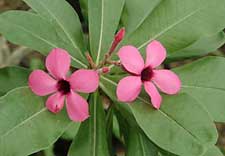 |
A clone of Adenium bohemianum with dark magenta pink flowers. Other clones have much lighter flowers. |
A peculiar species, with flowers similar to A. swazicum but very broad leaves, long periods of dormancy and poor flowering characteristics. We grow a few plants but have never tried to use it in any crosses. I know of one or two hybrids that seem to have A. bohemianum as a parent. Has never set seed for me.
Adenium oleifolium:
I have tried growing this several times from seed but the plants always rot during the monsoon. In my experience they are not slow growing but maybe the fast growth under my conditions made them so susceptible to rot. In future I would try and grow them slowly in low nutrient conditions.

© Copyright Tropica Nursery 2025. All Rights Reserved.
Maintained by MiracleworX Web Designer Mumbai